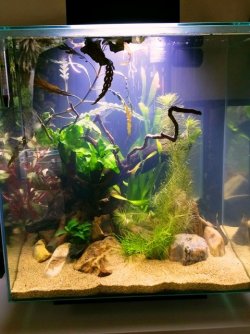MarcoPereira
Mostly New Member
Hi everyone. I have a new 46 litre Fluval Edge and have started the cycling process and, with the help of members here in another section of the forum I am being led in the right path.
One question for future reference though, in regards to stocking it, I have seen amazing stocked edges on Youtube and they look incredible...
I am wanting soft water in this aquarium and trying to recreate a mini amazon biotope.
My tap water here is about neutral to 7.3 Ph but after I add it to my Fluval it becomes acidic, dropping down to 6 or slightly less.
I have bogwood in there (2 pieces) and wonder if this was the issue in my cycling woes?
Also, I was given a light tan coloured sand and rocks but with the poor lighting it all looks very dingy and drab...plants help a bit but it just looks awful to me. Can I change the sand for a lighter colour and remove one piece of bogwood to lighten the look and perhaps raise Ph slightly? I have almond leaves which can give me the black water look later on but not adding them yet as don't want to muck up cycle.
I understand that most BB live in the filter so will changing things and draining tank muck everything up again? I am adding ammonia via a piece of fish that is left in a bowl of water and that has lots of ammonia in that solution.
Any advice on choosing fish and such for the look I would like to achieve?
Look forward to any tips and advice and am aware to not stock to many fish in there, I was thinking a pair of rams ( I know, foolish beginner) and some ember tetras as dither fish? perhaps some shrimp and and Otto or two or a trio of Corydoras to help keep sand clean?
Thank you so much for your time.
One question for future reference though, in regards to stocking it, I have seen amazing stocked edges on Youtube and they look incredible...
I am wanting soft water in this aquarium and trying to recreate a mini amazon biotope.
My tap water here is about neutral to 7.3 Ph but after I add it to my Fluval it becomes acidic, dropping down to 6 or slightly less.
I have bogwood in there (2 pieces) and wonder if this was the issue in my cycling woes?
Also, I was given a light tan coloured sand and rocks but with the poor lighting it all looks very dingy and drab...plants help a bit but it just looks awful to me. Can I change the sand for a lighter colour and remove one piece of bogwood to lighten the look and perhaps raise Ph slightly? I have almond leaves which can give me the black water look later on but not adding them yet as don't want to muck up cycle.
I understand that most BB live in the filter so will changing things and draining tank muck everything up again? I am adding ammonia via a piece of fish that is left in a bowl of water and that has lots of ammonia in that solution.
Any advice on choosing fish and such for the look I would like to achieve?
Look forward to any tips and advice and am aware to not stock to many fish in there, I was thinking a pair of rams ( I know, foolish beginner) and some ember tetras as dither fish? perhaps some shrimp and and Otto or two or a trio of Corydoras to help keep sand clean?
Thank you so much for your time.



